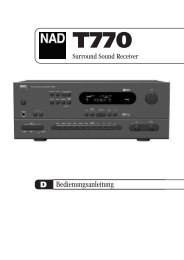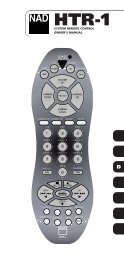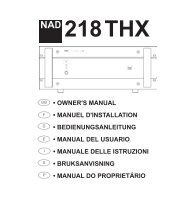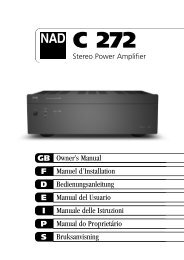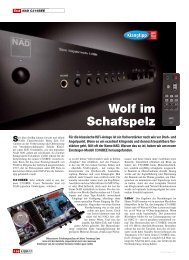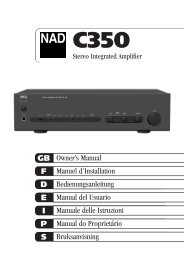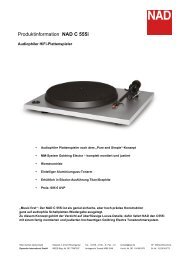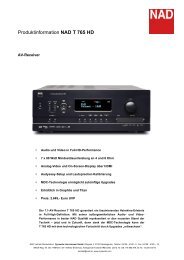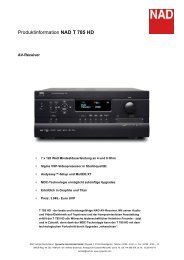C 372 - NAD
C 372 - NAD
C 372 - NAD
You also want an ePaper? Increase the reach of your titles
YUMPU automatically turns print PDFs into web optimized ePapers that Google loves.
ENGLISH FRANÇAIS DEUTSCH ESPAÑOL ITALIANO PORTUGUÊS SVENSKA<br />
Under normal operation, connect the right speaker to the terminals<br />
market 'R +' and 'R-' ensuring that the 'R+' is connected to the '+'<br />
terminal on your loudspeaker and the 'R-' is connected to the<br />
loudspeaker's '-' terminal. Connect the terminals marked 'L+' and 'L-'<br />
to the left speaker in the same way.<br />
In Bridge Mode, connect the single speaker to the terminals marked 'R<br />
+' and 'L+' ensuring that the 'L+' is connected to the '+' terminal on<br />
your loudspeaker and the 'L+' is connected to the loudspeaker's '-'<br />
terminal. Refer also to section "Bridging" in this chapter (No. 12).<br />
Always use heavy duty (16 gauge; 1.5mm, or thicker) stranded wire<br />
to connect loudspeakers to your <strong>NAD</strong> C <strong>372</strong>. The high-current<br />
binding post terminals can be used as a screw terminal for cables<br />
terminating in spade or pin sockets or for cables with bare wire ends.<br />
BARE WIRES AND PIN CONNECTORS<br />
Bare wires and pin sockets should be inserted into the hole in the shaft<br />
of the terminal. Unscrew the speaker terminal's plastic bushing until the<br />
hole in the screw shaft is revealed. Insert the pin or bare cable end into<br />
the hole and secure the cable by tightening down the terminal's<br />
bushing. Ensure bare wire from the speaker cables does not touch the<br />
back panel or another socket . Ensure that there is only 1/2" (1cm) of<br />
bare cable or pin and no loose strands of speakers wire.<br />
NOTE: Make sure the speaker impedance is 4 ohms or more when<br />
connecting only one pair of speakers; make sure the speaker impedance<br />
for all speakers is more then 8 ohms when connecting two sets of<br />
speakers. In Bridge Mode, the impedance of the loudspeaker should<br />
also be 8 ohms or higher.<br />
17. SWITCHED AC OUTLET<br />
The AC power cord of another component may be plugged into this<br />
accessory outlet. Components plugged into this outlet will be switched<br />
On and Off by the POWER button on the front panel or by the ON and<br />
STAND-BY button on the remote control handset.<br />
NOTE: The total power consumption of any components connected to<br />
the AC outlets may not exceed 100 Watts.<br />
18. IEC AC MAINS (POWER) INPUT<br />
The C <strong>372</strong> comes supplied with a separate AC Mains cable. Before<br />
connecting the cable to a live wall socket ensure that it is firmly<br />
connected to the <strong>NAD</strong> C <strong>372</strong>'s AC Mains input socket first. Always<br />
disconnect the AC Mains cable plug from the live wall socket first,<br />
before disconnecting the cable from the C <strong>372</strong> Mains input socket.<br />
FRONT PANEL CONTROLS (FIGURE 2)<br />
1. POWER ON/OFF<br />
Press the POWER button to switch the amplifier On. The Stand-by<br />
indicator (No. 2) over the power button will light up amber and after a<br />
short pause will turn to green to indicate the amplifier is now ready for<br />
normal operation.<br />
Pressing the POWER switch again will turn the unit OFF completely, it<br />
will not respond to the remote control.<br />
6<br />
REMOTE CONTROL (FIGURE 3) ON AND OFF BUTTONS<br />
Press the POWER button to switch the amplifier On. The Stand-by<br />
indicator (No. 2) over the power button will light up amber. Pressing the<br />
POWER switch again will turn the unit OFF completely, it will not<br />
respond to the remote control. The <strong>NAD</strong> C <strong>372</strong> remote has a separate<br />
On and Off button. This can be particularly useful to keep components<br />
within a system "in sync": This way all components will switch to standby<br />
when Off is pressed or switch to operating mode when On is pressed,<br />
instead of some components switching On when the amplifier is<br />
switched to Stand-by. (Note that the other components have to be<br />
capable of responding to the separate On and Off commands as well).<br />
Press the ON button to switch the unit from Stand-by to the operating<br />
mode; The Stand-by indicator (Fig. 2; No. 2) will turn from amber to red,<br />
then to green and the indicator for the last selected input will blink and<br />
light up. Press the OFF button to switch the unit to the Stand-by mode:<br />
The Stand-by indicator will light up amber.<br />
NOTE: In Stand-by mode the C <strong>372</strong> uses very little power. However, it<br />
is recommended that you switch the unit totally off if it is not going to<br />
be used for more than a couple of days. Switch off completely by<br />
pressing the POWER button on the front panel (No. 1), all lights will<br />
extinguish.<br />
2. POWER / STAND-BY / PROTECTION INDICATOR<br />
Upon switching the power on, the LED will light up amber in standby<br />
state. While one of the input select buttons is pressed, the LED will turn<br />
red for a moment, then turn green for ON state. In cases of serious<br />
abuse of the amplifier, such as overheating, excessively low loudspeaker<br />
impedance, short circuit etc. the amplifier will engage its Protection<br />
circuitry, indicated by the LED turning from green to red, and the sound<br />
being muted. In such a case, turn the amplifier off, wait for it to cool<br />
down and/or check the speaker connections, making sure the overall<br />
loudspeaker impedance doesn’t go below 4 ohms. Once the cause for<br />
the protection circuitry to engage has been removed, press Power again<br />
to resume normal operation.<br />
The diagram below shows the operation of the Stand-by / protection<br />
Green Amber Red<br />
Normal Operation •<br />
Stand-by •<br />
Protection •<br />
indicator:<br />
3. HEADPHONE SOCKET<br />
A 1/4" stereo jack socket is supplied for headphone listening and will<br />
work with conventional headphones of any impedance. The<br />
headphone socket will work in parallel to the selected speakers. To<br />
listen to headphones only, de-select Speakers A and/or B (No. 4).<br />
The volume, tone and balance controls are operative for headphone<br />
listening. Use a suitable adapter to connect headphones with other<br />
types of sockets, such as 3.5mm stereo 'personal stereo' jack plugs.<br />
NOTE: Make certain that the volume control is turned to minimum (fully<br />
counter-clockwise) before connecting or disconnecting headphones.<br />
Listening at high levels can damage your hearing.<br />
4. SPEAKERS A & B<br />
The Speakers A and B buttons engage or disengage the speakers<br />
connected respectively to the Speakers A and Speakers B terminals on<br />
the rear panel. Press A to switch the speakers connected to the speaker<br />
A terminals On or Off. Press B to switch the speakers connected to the<br />
speaker A terminals On or Off. The indicator directly over the buttons<br />
shows the status of speakers A and B.



